
Hair loss is a common concern for many individuals. A hair transplant offers a permanent and reliable solution. It’s a surgical procedure involving transplanting hair follicles from the donor area to balding regions, resulting in natural-looking and long-lasting results. While the prospect of regaining lost hair is enticing, it is essential to understand it fully. We’ll go over the safety of hair transplants, the precautions implemented by skilled doctors, and common side effects patients may experience during the recovery process.
Safety First
Advancements in technology and techniques have made hair transplants one of the safest and most effective ways to address hair loss. The procedure primarily involves harvesting hair from the donor area, usually located at the back of the head, and transplanting the follicles into the balding area. Since the transplanted hair comes from the patient’s own body, the risk of rejection is eliminated.
Furthermore, hair transplants are typically performed under local anesthesia, ensuring a painless experience during the surgery. After the procedure, patients can return home the same day and then resume their regular activities within a few days. Any post-operative discomfort can be managed with prescribed pain medication and antibiotics are given to prevent infections. Regular follow-up appointments with the doctor are scheduled to monitor the recovery progress and address any concerns that may arise.
To maximize safety, it is crucial to choose an experienced and skilled doctor with a proven track record of successful hair transplants. An expert surgeon not only performs the procedure accurately but also handles any potential complications during or after the surgery, leading to a smoother recovery process.
Precautions and Postcautions
Although hair transplants are generally safe, there are certain precautions that doctors take to ensure a smooth and complication-free procedure. Before the surgery, a series of medical tests may be conducted to assess the patient’s overall health condition. It is vital to disclose any relevant medical history and medications, as certain drugs, such as blood thinners, may impact the surgical process.
To guarantee patient safety during the hair transplant procedure, doctors adhere to specific safety measures, including:
- Sanitizing and sterilizing: The surgery room and all equipment are meticulously cleaned and sanitized before the procedure. Surgical tools are sterilized to minimize the risk of infections.
- Safety gear and cleanliness: Doctors and their team wear appropriate safety gear during the surgery. Patients are provided with disposable clothes, and their hair is washed before the transplant.
- Dressing the transplant area: Proper dressing of the transplant area promotes a faster and smoother recovery process.
- Post-operative care: Patients are given professional advice and recommendations on how to take care of their scalp after the procedure to facilitate optimal healing.
The Fine Print
As with any surgical procedure, individuals may experience various side effects following a hair transplant. These side effects are typically minor and temporary, subsiding within a few days or weeks. Common post-operative side effects include:
- Tender or itchy scalp: Patients may experience mild discomfort or itching around the transplant area, which usually resolves on its own.
- Hair shedding: Approximately 2 to 3 weeks after the procedure, patients may notice some hair shedding. This is a natural part of the healing process as the transplanted hair follicles adjust, making way for new hair growth.
- Swelling: Some individuals may experience mild swelling on the scalp, which usually resolves without intervention.
- Numbness: Temporary numbness in the treated areas may occur, but it should gradually subside as healing progresses.
The Bottom Line
Hair transplants offer a safe and effective solution for individuals suffering from hair loss. With advancements in technology and surgical techniques, the procedure has become even more reliable, providing natural-looking and long-lasting results.
By choosing an experienced and skilled staff, like at Advanced Medical Hair Institute, and adhering to necessary precautions, patients can undergo a hair transplant with confidence and minimal risks. While some post-operative side effects may occur, they are typically temporary and part of the healing process. For those seeking a permanent solution to hair loss, a hair transplant can be a life-changing option, boosting self-confidence and restoring a fuller head of hair.Schedule A Consultation today to find out more.










